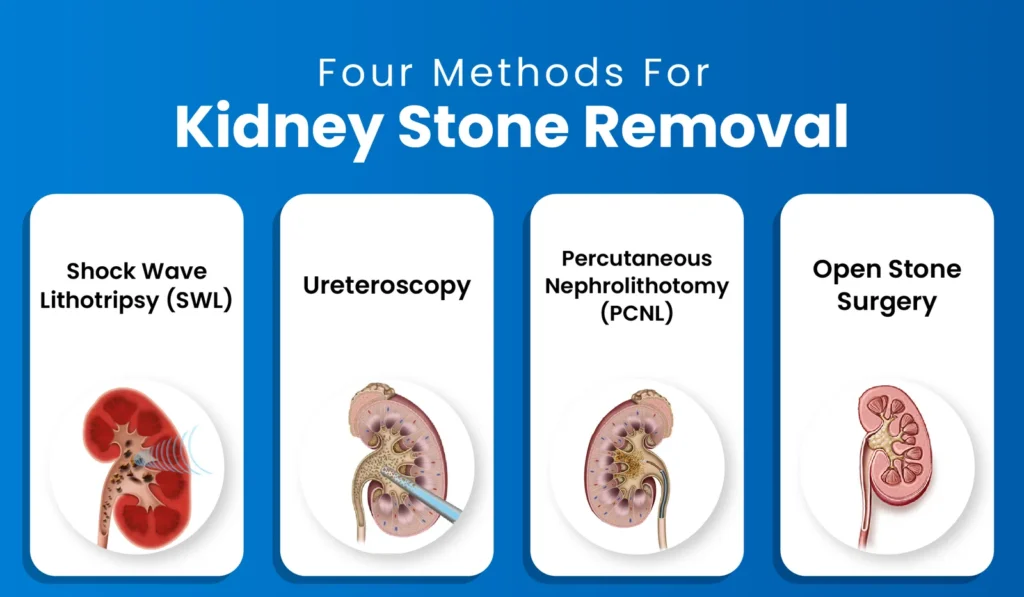
Introduction
When a kidney stone decides not to pass on its own, or if it’s causing severe pain, infection, or kidney damage, medical intervention becomes necessary. Thankfully, modern urology offers several effective methods for kidney stone removal, many of which are minimally invasive. Understanding these options can help alleviate anxiety and prepare you for discussions with your urologist.
I am Dr. Venkatesh Kumar, a Urologist, Sexologist, and specialist in advanced Robotic Surgery, serving patients throughout Noida and Noida Extension. Deciding on the best way to remove a kidney stone is a crucial step, and my goal is to provide you with clear, comprehensive information about the procedures available, drawing upon established medical practices discussed by institutions like Apollo Hospitals and incorporating the latest advancements offered at my clinic.
When Is Kidney Stone Removal Necessary?
Not every kidney stone needs active removal. Small stones may pass spontaneously with hydration and pain management. However, intervention is typically required if the stone:
Is too large to pass naturally.
Causes unbearable or persistent pain.
Blocks the flow of urine, potentially damaging the kidney.
Causes ongoing urinary tract infections (UTIs).
Is associated with bleeding.
Is growing in size.
Exploring Your Kidney Stone Removal Options
The best treatment depends on factors like the stone’s size, location, type (composition), and your overall health. Here are the primary methods used today:
Shock Wave Lithotripsy (ESWL)
What it is: A non-invasive procedure using high-energy sound waves generated outside the body.
How it works: These focused shock waves travel through the skin and tissues to target the stone, breaking it into smaller fragments that can then be passed more easily in the urine over days or weeks.
Best suited for: Certain stones located within the kidney or upper ureter, typically less than 1.5-2 cm, depending on density and location. It’s performed on an outpatient basis, often with sedation or light anesthesia.
Ureteroscopy (URS) / Retrograde Intrarenal Surgery (RIRS)
What it is: A minimally invasive procedure using a very thin, lighted tube with a camera (ureteroscope) passed through the urethra and bladder into the ureter and potentially the kidney.
How it works: Once the stone is visualized, it can be broken up using a laser fiber passed through the scope, and the fragments can be removed with a tiny basket. RIRS specifically refers to using a flexible ureteroscope to reach stones within the kidney itself.
Best suited for: Stones located in the ureter or smaller stones within the kidney. It’s highly effective, especially for stones that ESWL might not treat well. It usually requires general or spinal anesthesia and may involve placing a temporary stent.
Percutaneous Nephrolithotomy (PCNL)
What it is: A minimally invasive surgical procedure used for larger or more complex kidney stones.
How it works: A small incision (about 1 cm) is made in the back, creating a direct tunnel into the kidney. A nephroscope is inserted through this tunnel to visualize the stone. The stone is then broken up using specialized instruments (like ultrasonic or laser probes) and the fragments are suctioned out.
Best suited for: Large stones (typically > 2 cm), staghorn calculi (stones filling large parts of the kidney’s collecting system), or stones resistant to ESWL or URS. It requires general anesthesia and a short hospital stay.
Robotic-Assisted Surgery (e.g., Robotic Pyelolithotomy/Nephrolithotomy)
What it is: A highly advanced minimally invasive technique utilizing robotic technology.
How it works: Performed through small keyhole incisions, the surgeon controls robotic arms equipped with specialized instruments and a high-definition 3D camera. This allows for exceptional precision, dexterity, and vision.
Best suited for: Very complex situations, such as extremely large stones, stones associated with anatomical abnormalities (like UPJ obstruction) requiring simultaneous repair, or cases where other minimally invasive methods may be less suitable. As a specialist in Robotic Surgery in Noida, I utilize this technology to offer patients minimal scarring, reduced pain, and faster recovery in appropriate complex cases.
Open Surgery (Rarely Needed)
What it is: Traditional surgery involving a larger incision in the side or abdomen to directly access the kidney or ureter and remove the stone.
Why it’s rare now: Due to the success and advancements in minimally invasive techniques (ESWL, URS, PCNL, Robotics), open surgery is reserved for only the most complex or unusual cases where other methods are not feasible or have failed.
Choosing the Right Kidney Stone Treatment in Noida
Selecting the most appropriate removal method is a decision made collaboratively between you and your urologist. I will carefully evaluate your specific situation—considering stone characteristics from imaging (like CT scans), your health status, and your preferences—to recommend the safest and most effective treatment option available here in Noida.
Dr. Venkatesh Kumar: Expertise in Modern Kidney Stone Removal
At my practice, serving Noida and Noida Extension, we are equipped to offer a comprehensive range of kidney stone treatments, from non-invasive ESWL to advanced minimally invasive procedures like URS, PCNL, and state-of-the-art Robotic Surgery. My focus is always on providing personalized care using the least invasive, most effective approach for your unique condition.
Conclusion
If you have a kidney stone that requires removal, rest assured that effective, often minimally invasive options are available. Understanding these treatments is the first step toward resolving your kidney stone issue and getting back to a pain-free life.
Don’t let kidney stones dictate your health. If you’re in the Noida or Noida Extension region and need evaluation or treatment for kidney stones, schedule a consultation with me, Dr. Venkatesh Kumar. Let’s discuss the best removal option for you.

